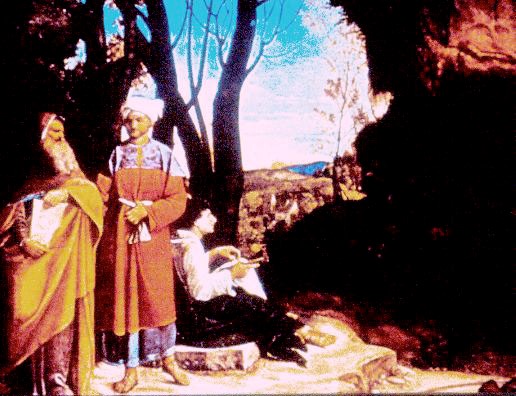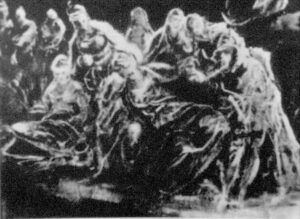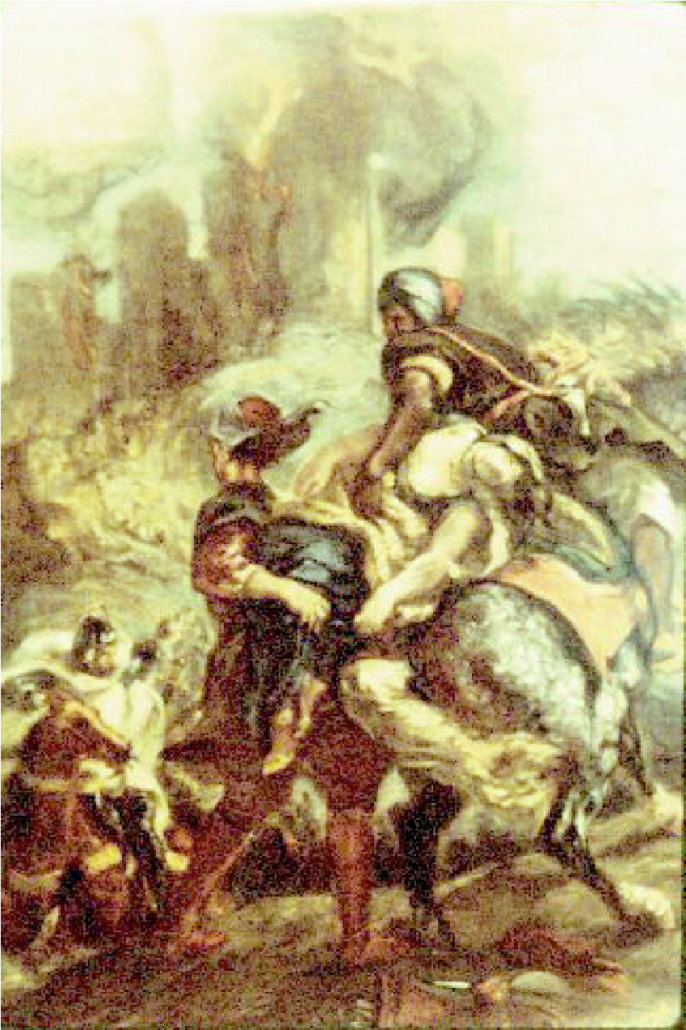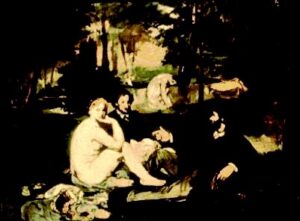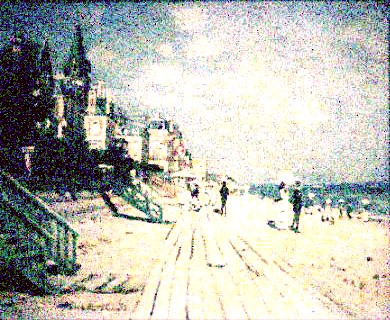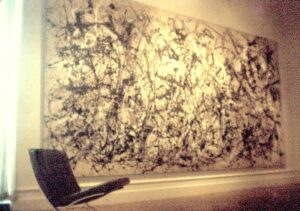Painting: Direct or Indirect?
At the close of Chapter 8, we contrasted the “direct” quality of welded sculpture by Barbara Lekberg with more systematic, “indirect” work (a bronze-casting) by Auguste Rodin. (In bronze process, a preliminary model is precursor to the lost-wax phase, and the actual “pour” is often handled by specialists in metalurgy.)
This direct/indirect contrast may be an apt metaphor of human creativity on many levels, reflecting the differing physiology of “right brain/left brain” approaches.
“Left-brain” art-making is typically the result of logical stages in a predetermined sequence (such as bronze-casting), while “right-brain” art is generally spontaneous and improvizational — relying upon virtuosic choices of the artist “in the moment”to achieve unique outcomes.
Indeed, one discovers just such a direct-indirect/right-brain-left-brain dichotomy in much of the complex world of visual imagery — in particular, that phase of the history of Art since 16th-and 17thcentury European masters began personal stylistic experiments with conventions evolved during the Renaissance in Italy and the Low Countries.

The Approaching Storm (Fig. 9-3/left), a late work of the Venetian, Giorgione, couches obscure Humanistic symbolism in painterly, “atmospheric” style.
These “conventions,” such as linear perspective, aerial perspective, foreshortening (spatial illusion) and rational color (Fig. 9-1) became a language of academic art practiced and taught in ateliers throughout much of Europe and later in the New World.
Post-Renaissance acceptance of “canons” of balance, symmetry, control of pictorial space, truthfulness to Nature, and a mix of Christian and NeoPlatonic values required the evolving artist to master a host of journeyman’s skills enroute to joining the painters’ guild.
When oil paints largely displaced Fresco and Tempera of the Early Renaissance, paintings were initiated with preparatory sketches, careful drawing on a “ground” spread over canvas or wood panel, then multiple brushed layers of under-paint were followed by final color-mixing and glaze-application. This defined the “indirect” or “academic” approach to painting which remains intact in some studios in the 21st century.
One important characteristic of many of these “indirect” works is a naturally-occurring, “linear effect” (i.e. clearly-defined edges of forms), which, combined with “local color” (color that coheres with the object, as in Fig. 9-1) emphasizes the object painted, rather than the painting process.
While the illusion of depth had been successfully achieved with this linear approach (which postulates a “virtual window on reality”), it was Venetian artists, especially Giorgione (Figs. 9-2 and 9-3) and later, Tintoretto (Fig. 9-4 and detail) who seem to have initiated atmospheric experiments which effectively merged figure-and-ground (read “foreground and background.”)
The painterly approach asserts the plane of the canvas (because brushwork is generally visible) and makes any illusion of space dependent upon subtle atmospheric effects and color, rather than upon drawing (foreshortening).

Detail of El Greco’s St. Martin and the Beggar (Fig. 9-5, left/1597) exhibits linear bias, supplanted in 1600 by more painterly treatment of The Repentant St. Peter (Fig. 9-6, right/detail.)
As noted above, in a linear production such as Fig. 9-1, the painted object remains discrete from its surrounding ground, while in a painterly performance that figure-and-ground merge in a unified field of brushwork which fuses objects and their surroundings in a perceptual transcription of light, color, atmosphere and movement on a flat surface.
With the direct method, spontaneity takes precedence over protocol (Renaissance conventions) and the artist’s signature brushwork becomes the sine qua non of a “successful” performance. (It is probably for this reason that we have called the “direct method” painterly, and refer to products of the “indirect method”as linear.) Giorgione began his brief career with a linear bias and culminated it by launching a painterly revolution.
Turmoil of the Counter-Reformation in all likelihood made “Classical” aspects of the indirect style too limiting for painters such as El Greco, (Fig. 9-5 & Fig. 9-6) Rubens and Rembrandt. By the first half of the 17th century, a trend emerged which would ultimately lead Mannerist, Baroque and Rococo artists to abandon a “Classical viewpoint” for the expressive license of direct painting technique.
In the North, Rubens — who died about 1640 in Flanders (modern Belgium) — explored new levels of verisimilitude with his facile brushwork (see 6-10 & 6-13), which only in later years seemed to transcend sensuous description in favor of spiritual focus (Fig. 9-7).

Contemporaneous Dutch painters reveal historical tension between the traditional indirect style (Fig. 9-8, det. Vermeer’s Maid Pouring Milk, 1660/ left) and improvizational brush-work of Rembrandt’s mysterious SelfPortrait (det., Fig. 9-9, 1666, right).
As Holland moved from Spanish rule (and the passions of the Counter-Reformation) to a Protestant aesthetic (which sought to replace “Catholic” religious subject-matter with something more appropriate to a mercantile society), we can see the divergence between a methodically-drawn image, chiaroscuro and rational color (Fig. 9-8, Vermeer) and Rembrandt’s confounding of the senses by spontaneous mixing of color, light and pigment on the canvas (Fig. 9-9).
By mid-17th century, Academies began to replace time-honored Guilds as the locus of formal training, and as Paris came into ascendancy as Europe’s epicenter of taste, lines were drawn between “Rubenists,” with their bold painterly bias, and “Poussinists” who still advocated the meticulous drawing and ideal color-schemes of their namesake — a Frenchman who defected to Classical Rome about 1624. Emergence of the French Bourgeoisie may have added further social impetus to the widening division between direct and indirect schools of painting in the Rococco era.
Two 18th-cen. French masters aptly embody direct/indirect viewpoints in the years leading up to the French Revolution: Watteau painted apocryphal celebrants of Embarkation for the Isle of Cytheria (Fig. 9-10) with vaporous forms and a pervasive sense of aristocratic taste. His contemporary, J. B. Chardin, painted a Kitchen Maid (Fig. 9-11) with equal passion, relying on time-honored drawing technique and then applying restrained color to develop his tribute to working class consciousness. Louis LeNain had elevated French peasant life to a level of bucolic idealism a century earlier, but Chardin peered unashamedly into kitchens of the Bourgeoisie — there to find still-life arrangements wherein a maidservant becomes adjunct to brilliantly-executed studies of pots and pans. (Fig. 9-12)

Painterly atmospheric effects abound in Watteau’s Embarkation for the Isle of Cytheria (Fig. 9-10/detail, left) while Chardin’s (Kitchen Maid, Fig. 9-11/right) still pays homage to traditional indirect techniques.
H. Fragonard, one of the last voices of Rococco Style in 18th-cen. French Painting, practiced his virtuosic style of brushwork (Fig. 9-13) until Neoclassicism became the anointed aesthetic of the French Revolution (its formal, indirect approach to art-making flourished in the Academy under Napoleon).
Jacques-Louis David (Fig. 9-14) and his student, Ingres, successfully “wedded” Republicanism, Classical idealism and time-tested Renaissance technique to develop a quintessentially indirect pictorial canon. This proved to be a sufficiently-potent formula for export to the United States, where it dominated into the 19th century.
Early-19th cen. French Romantics such as Delacroix and Gericault, however, saw spontaneity at the heart of the creative equasion. When not chronicling the Revolution, Delacroix traveled to Morocco in search of worthy subject-matter (Figs. 9-15 & 9-16). While Ingres searched for a “timeless”metaphor of patriotism in his theatrical Apotheosis of Homer (Fig. 9-17), Gericault would paint subjects with mental derangement or victims of war in the clutch of existential reality. (Fig. 9-18)
Probably it was this “existentialism” coupled with the rise of a French middle-class which enabled the direct style to surpass the indirect in popularity by mid-19th cen. It was at this same moment in technical evolution that the Daguerreotype (early French photography) rendered Neo-Classical idealism “out-of-date,” while elevating brushstroke to a distinguishing “mark” of authenticity.

Photographic quality of David’s 1812 “Neoclassical” Napoleon in His Study (Fig. 9-14, detail/far left) contrasts dramatically with painterly treatment of The Warrior (Fig. 9-13, detail/right) by Fragonard, who died but six years earlier.
If Giotto was a critical “link” in 1300 AD between Medieval consciousness and the Humanistic era, I think of Edgar Degas and Edouard Manet as initiating the long leap to Modernism in the 19th century.
For it was these two French iconoclasts who launched their careers looking toward traditions of the past and evolved through adversity into spokesmen for the coming ages of Impressionism and beyond.
Compounding aesthetic impact of new Daguerreotypes, Degas and many of his contemporaries were also galvanized by a flood of Japanese woodblock prints arriving in Paris, suggesting new “unclassical” possibilities for asymmetry or occult handling of picture-space. One can readily see the zest with which Degas assimilated this new-found spatial freedom, in pictures such as Absinthe, for which he posed a painter/writer and actress (Fig. 9-21). The artist’s abiding interest in plastic organization appears to have been “built in” by indirect manipulation of light-and-dark pattern in the initial stages of a work (as in Fig. 9-20).
By 1890, the artist’s sight problems motivated him to work in Pastel (Fig. 9-22), and one can see diminution of illusory space and assertion of the “decorative” potential of pattern on a flat picture-plane — a harbinger of the approaching 20th-century.

Romantic light and chiaroscuro link Gericault’s Trumpeter of Hussars with past painterly traditions (Fig. 9-18/ left). Idealism and optical reality merge in Neo-Classical ambience of The Apotheosis of Homer (Fig. 9-17, 1827/ right) by J. Ingres. “Brushwork” is anathema here.
It’s probably specious to attribute a singular role to any one among the band of artists that ushered in the Impressionist Era, for they shared with one-another regularly in discussions at Cafe Guerbois and later at Nouvelle-Athenes. Degas met Manet as early as the 1860s, and a contemporary writer, Silvestre, wrote of Manet: “He was one of the first to brighten the French palette and bring light back into it.”
There is not much of that light, however, in Le Dejeuner sur l’herbe (Fig. 9-23, 1863), which found exposure only at the Salon des Refuses, a venu for works rejected by the Ecole de BeauxArtes. Manet’s The Balcony (Fig. 9-24) of 1868 – 69, for which painter, Berthe Morisot had modeled, begins to investigate light-reflecting surfaces and more venturesome brush-stroke. By 1874, in Boating (Fig. 9-25) the artist mixed direct brushwork with white under paint, which became a hallmark of Impressionist language.
The name,“Impressionism,” which came into being as a pejorative term — branding as inept work that violated canons of academic style — now rapidly captured the Zeitgeist of a Western society entering the scientific/industrial era. Painters like Monet, Renoir, and Pissaro increasingly sought to complement the new social milieu with middle class, leisure-oriented subject-matter. And they equally welcomed new scientific understanding of optical experience, based on experiments with theories of human perception.

Underpaint sketch for unfinished Femme au Tub (det. Fig. 9-20, left) shows Degas’ systematic development of plastic scheme, as in Absinthe (Fig. 9-21, 1876/right).
Whereas Renaissance Masters had reorganized reality according to such Classical values as balance, order, and harmony, the Impressionists saw in the camera a model of disinterestedness more in keeping with the scientific age. Thus emerged a new canon which wedded science, middle-class values, the spontaneity of Romantics and accumulated acheivements of direct painting style from the time of the Venetians.
Seen in a gallery filled with Impressionist paintings, this synchronicity of values appears “simple and inevitable.” Yet the convergence of cultural and scientific influences flowing together in the last quarter of the 19th century to create the Style we know as Impressionism was unprecedented:
A. Social
Middle-class subject-matter
Leisure-oriented
Outdoor setting (light)
Sun-drenched palette (optimism)
B. Scientific
Color mixed in the eye (not on palette)
Even “surface-tension”(planar)
Shadows are complementary (no grey)
Disinterested vision (no plastic content)
Rational color (as in Nature)
C. Aesthetic
White under-painting (luminosity)
Preferred cool color-scheme
Technique more important than subject
Spontaneous brushwork
Improvizational style (Direct approach)
In Fig. 9-29, one experiences the same “disinterested” vision that Degas had assimilated from Japanese prints (see Chap. 5, Fig. 5-12).
Titled The Church at Vernon, Monet’s treatment gives no special visual importance to the Cathedral either by heightening contrast, color-distortion or exaggerated lighting. The distant image is much as the human retina might have seen it, veiled in a cool atmospheric haze. White sizing of the canvas in advance of the “on-site” improvization is everywhere felt in the composition, which as a result, is filled with luminosity.

Le Moulin de la Galette by Renoir (Fig. 9-26, 1876) mixes science of optics with bourgeois, leisure values in “disinterested” composition (absent academic design).
It becomes obvious as one looks at Impressionist canvases, such as Figs. 9-28, -29, -30, that the “subject matter” was often incidental, as in the case of Monet’s Mme. Monet Under the Willows (Fig. 9-30). When seen at close proximity (detail), the artist’s wife becomes little more than a jumble of brushstrokes, scarcely differentiated from her surroundings.
The point is that a Western painting tradition which had originally focused on religious subject-matter, then searched for secular topics and an academic style worthy to “depict” them — now had identified a new raison d’etre:vision itself, and exploration of disparate artistic avenues by which that vision might be explicated. Since the Daguerreotype had robbed painters of the descriptive function the Renaissance had assigned journeyman artists, what remained was what they excelled at: seeing brilliantly. No broth of science and aesthetics had ever done this so triumphantly, nor with so little deference for the outcry of the art-establishment. In the ensuing imbroglio, a course was set toward eventual dominance of the “picture plane” over that “illusory space” so painstakingly carved-out after Giotto and Masaccio by Uccello, Ghiberti and Piero Della Francesca.

Impressionists insisted on painting “on site” at specific hours of the day, as in Monet’s The Church at V ernon (fig. 9-29)
But perhaps a more interesting question for the art historian concerns the fascination Impressionism seems to have had for generations of collectors and museum-goers. Is there something special about that radiant vision that has mesmerized millions?
This writer has no profound wisdom to offer on the question, except to recall that Perception is one of the cardinal aspects of Psychology, and vision is among our most important means of “knowing reality.”
Thus, most of us have the feeling that if we can see something clearly, we can “know it.” When painters such as Monet offer us all the sensory wonders of the beach (as in Fig. 9-32) and we “explore” the perception, expecting to experience it as the artist must have, our perceptive apparatus is strangely tittilated to discover that all we really “have” is little gobs of pigment on a canvas. In other words, our sense of “reality” is tweaked much as powerful theater can — and we are left with a combination of awe and illusion.
Impressionist “concensus” around “disinterestedness,” rational color and “unstructured visual experience” did not survive the end of the 19th century — although “plein air” painting has prospered, particularly in America, until the present day (Fig. 9-31). Painters in Europe, dubbed “PostImpressionists,” turned to color as the new frontier, borrowing much of the Impressionists’ revolutionary vision, while rejecting their cool, scientific emphasis in favor of passionate advocacy.

Virtuosic brushwork and ephemeral lighting conditions become “subject” of Monet’s Mme. Monet under the Willows, (Fig. 9-30, left and detail right) 1890.
One of this second generation, Georges Seurat, forged a curious marriage between Impressionist technique (preoccupation with light and retinal color-mixing) and a unique restatement of the classically-plastic structure of Poussin. Seurat’s “Pointalism” (though color is quantitatively applied) appears direct and spontaneous, yet his methodology is typically indirect — careful drawing, linear articulation of forms and use of aerial perspective (see Chap. 10) to define deep space.
Seurat’s color at times stretched the envelope of “rationality” or normal retinal experience (see Fig. 7-13), but it was Cezanne who ultimately turned the Impressionists’ experiments with direct brushwork toward more systematic analysis of color. Cezanne replaced the Impressionist penchant for a cool, outdoor palette with an implacable conviction that the artist could control the viewer’s perception of space by manipulating a narrow range of warm and cool color on the canvas. Gone were the refined “tools of illusion” so carefully honed by generations of painters (foreshortening, atmosphere and chiaroscuro), and in their place, brushstrokes of green, blue, ochre, orange and red so-arranged that mountains hover in the distance like stage-props in a vast proscenium theater. Cezanne’s space is not an earthly space marked in kilometers, but physiological space, defined by the glow of warm wedges of red-orange pigment edging forward from a receding ground of cool blue-green brushstrokes.

“Flattening” the picture-space with control of warm and cool color becomes paramount in Cezanne’s Mont St. Victoire (Fig. 9-34, 1904 and detail, left). Note planar facets of color-application, anticipating Cubism. Optical experience of a “natural” landscape in American West (Fig. 9-35, right) reveals Cezanne’s spatial restructuring in Fig. 9-34 above.
Cezanne’s mission appears to have been to reinvent pictorial space, simultaneously paying homage to Impressionists’ respect for the “picture plane” (as opposed to “illusionistic space”) while introducing color-tensions that created a perceptual equivalent of that illusionistic (Renaissance) spatial experience.
In the detail of Fig. 9-34, one can readily see how warm orange and yellow/ochre “project” as from a “near plane,” while emerald-green areas are relatively recessive, especially when interspersed with the blue of “distant” Mont St. Victoire. Paradoxically, the plane of mountain-and-sky pushes forward (since blue is relatively warmer than the intervening landscape of green), tending to “flatten” the canvas as a whole.
Cezanne’s was a direct approach to the painting process (landscapes improvised “on site”) though it is suggested the artist often sized his canvases in advance with grey underpaint, rather than white. Application of oil paint in characteristic “blotches,” rather than Impressionist “brushstrokes” has earned Cezanne a role as “precursor” of Cubism among some art historians. Clearly, he inspired such figures as Bonnard and later Matisse to push chromatic / spatial experimentation to new levels of intensity.
The apotheosis of direct painting style, of course, came in the person of Vincent Van Gogh, who, after carefully schooling himself in academic drawing technique, found his affinity was for color used for emotional impact rather than for spatial control. While Cezanne, the erstwhile banker, turned to the structuring of “outer” space, Van Gogh, after failing as a cleric, addressed the pathos of “ inner” space — both finding in color the focus of their revision of Impressionist dogma.
Vincent had a fling at Impressionist technique seen in Fig. 9-36, Corner in the Park (and detail) which, almost verging on Pointalism, bathed the landscape in that emotionless luminosity which savored detached vision over subjective insight.

Jackson Pollock was studying Jungian analysis at the time he painted Abstract Expressionist canvas (Fig. 9-40, title uncertain) shortly before his fatal automobile tragedy of 1956.
But the artist would move rapidly from his academic (indirect) beginnings to a wholly direct expression of subjectivity. (See Figs. 7-3 and 7-5) As his mental health became of greater concern, b ru s h s t ro k e s grew increasingly rapid and color less linked to narrow descriptive pathways. (Fig. 9-37) When his brother, Theo, was unable to find buyers for his work, Vincent ironically was liberated to explore uses of color that pleased his own sensibilities and eventually opened the flood-gates of modern Expressionism (Fig. 9-38).
Van Gogh’s color rarely broke the bonds of rationality, but in works such as Starry Night he defied descriptive canons of academic style by directly rendering kinesthetic forms with visible brushstrokes laden with pure color and convoluted emotion.
Weaving the thread of direct painting-style from 16th-century Venetians to Van Gogh and thence to the 20th Century would certainly require acknowledgment of Kandinsky, among others, who in turn, influenced the American, Jackson Pollock.
Exposed to Native American sand-paintings during his childhood in Wyoming and murals of the Federal Arts Project during the Depression, Pollock was schooled in New York by no less a “traditionalist” than Thomas Hart Benton (see Figs. 1-12 and 7-14).
Internalizing Thomas Hart Benton’s capacity to organize mural-sized productions, Pollock expanded direct painting style into a contemplative athletic event, wherein paint was poured and spattered over wall-sized canvas arrayed on his studio floor. (See Fig. 9-39) Dubbed “action painting” by a New York critic, this spontaneous “mannerism” was later abandoned by Pollock in favor of a more “Jungian” expression (Fig. 9-40), shortly before he died in a speeding automobile in 1956. Similar biomorphic and perceptual elements in Vincent Van Gogh’s Starry Night (Fig. 9-38) may suggest that introspective quests of both artists eventuated in unsuccessful attempts to reconcile their disparate “inner” and “outer” worlds.
Ironically, before the Impressionist revolution, the term “virtuosic” (usually applied to direct, improvizational painting) was often associated by “classical” critics with distortions of “reality.” In their eyes, indirect style: the objective eye and anonymous “observer,” provided a “truthfulness” prized since the Van Eycks and Massacio.
Consideration of this matter of “truthfulness” has been reserved for Chapter 10, in which we shall note that “truth-in-art” is often bound with canons of “Reality.” We shall differentiate Reality from Realism, decipher visual reality from its cousin, mental reality, and explore some of the artistic “ploys” refined through generations to coopt the viewer in an illusionistic partnership with the artist.
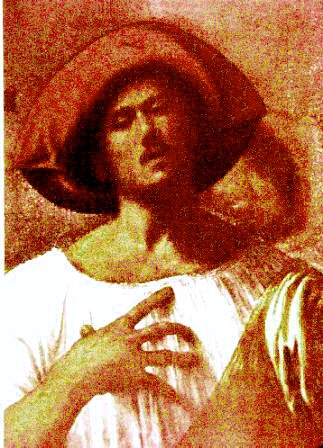
Reflecting lucidity and linear bias of the High Renaissance, The Three Philosophers by Giorgione (Fig. 9-1, pre-1510, top) embodies traits associated with an indirect style. Artist’s later, more direct style is shown in Cantor e Appassionato (Fig. 9-2, above).

Detail (top) of Tintoretto’s Baptism of Christ (Fig. 9-4 ) indicates spontaneous brushwork with which artist merges figures into dark ground.
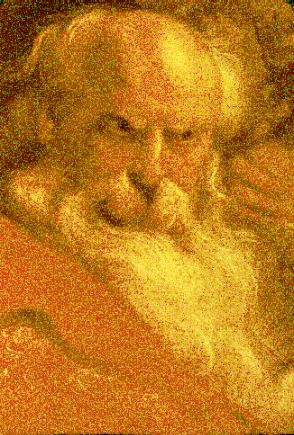
Northern Baroque expression of Flemish artist Peter Paul Rubens (Fig. 9-7, detail: Adoration of the Magi) departs from sharply-articulated imagery of earlier Flemish tradition, merging figure/ground.
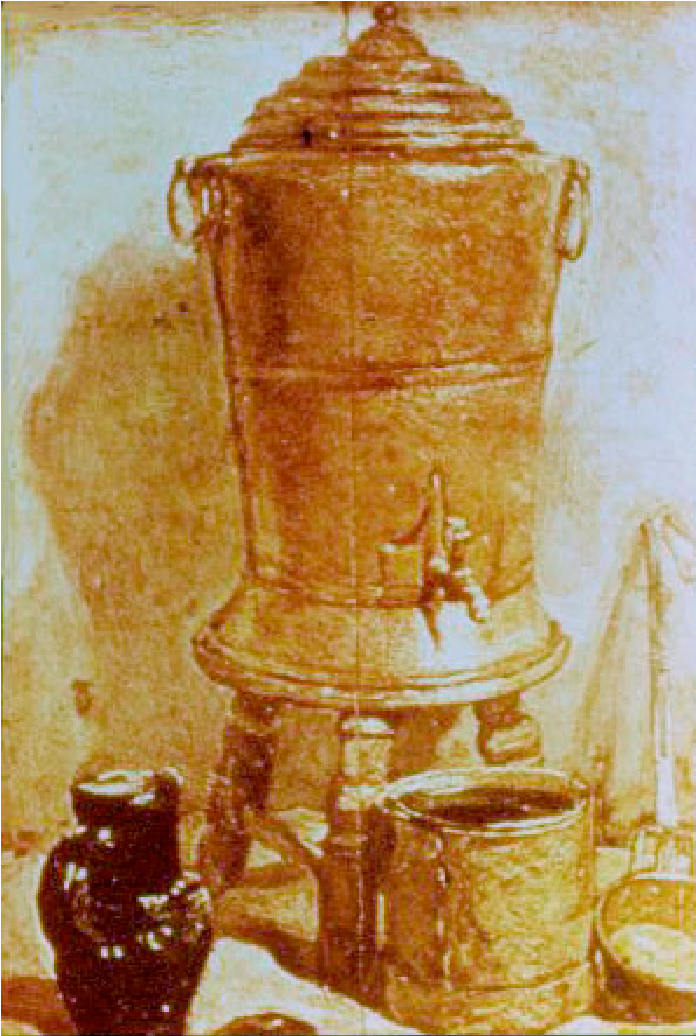
Chardin’s Copper Tank (Fig. 9-12), like Vermeer’s “objects,” is suffused with light and a typically “Northern” linear clarity.
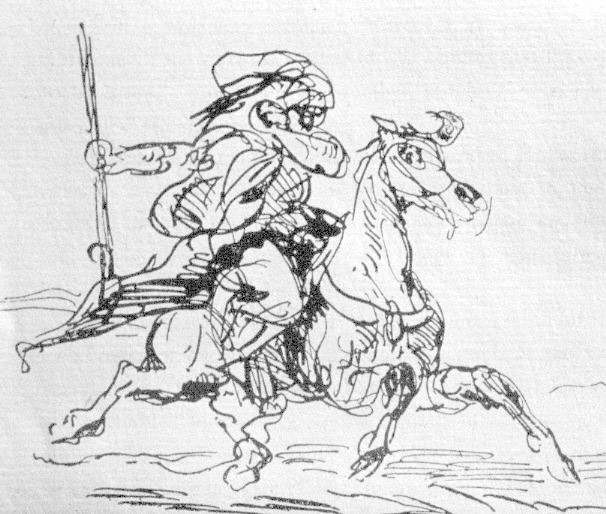
Drawing becomes bridge to pathos in direct style of Romantic, Delacroix, whose Moroccan Horseman (Pen & Ink, Fig. 9-15 , of lion attacking Arab, above) served as inspiration for canvases such as The Abduction of Rebecca (Fig. 9-16, det., top).

Uncle and Niece, a family portrait of 1876, reflects Degas’ conservative background in drawing, arrangement of forms and rational color (Fig. 9-19 ).

Edgar Degas embraces a direct medium, Pastel, which negates Renaissance spatial illusion. The Morning Bath of 1890 (Fig. 9-22) looked ahead to abandonment of indirect technique by avant garde painters in Europe and eventually in America.

Like Degas, Edouard Manet ran the gamut from early indirect technique (Le Dejeuner sur l’herbe, Fig. 9-23, top) to increasingly diminished drawing and spatial illusion in The Balcony, Fig. 9-24, above).

Romantic “dark ground” gives way to new aesthetic of light (white underpaint) in Manet’s Boating (Fig. 9-25) of 1874.

Monet’s Le Moulin de la Galette by Renoir (Fig. 9-26, 1876) mixes science of optics with bourgeois, leisure values in “disinterested” composition (absent academic design).
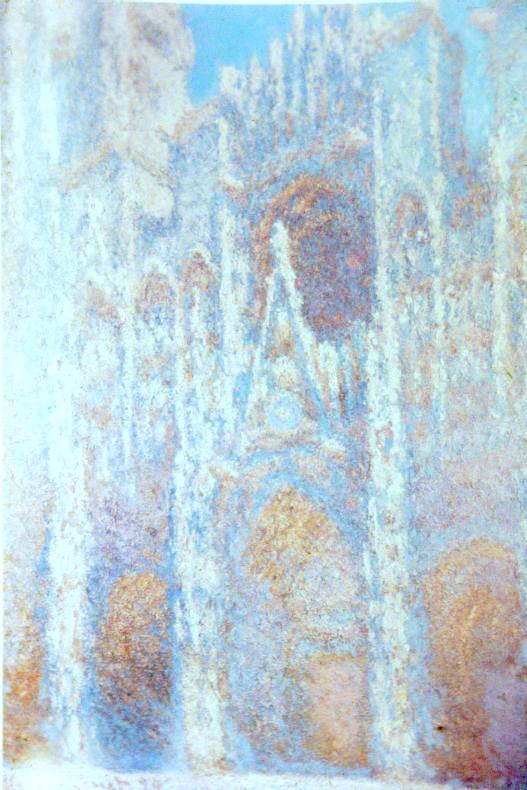
Notre Dame of Rouen, Sunset was one of a series of “portraits” of ephemeral lighting-conditions Monet observed at distinct periods of the day, and recorded on separate canvases. Note complementary (orange) shadows within bluish portals (Fig. 9-28) and equal “surface-tension” (absence of obvious plastic design).
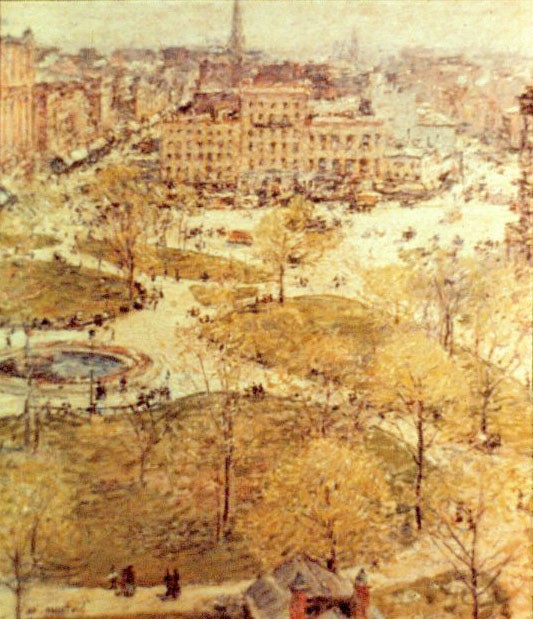
American artist, Childe Hassam, painted Union Square in the Spring (Fig. 9-31). Typical American Impressionist palette is less chromatic than European counterpart.

Direct, on-the-spot, painting of Monet’s Beach at Trouville (Fig. 9-32, and details) creates tension between optical “reality” and pastiche of pigment on “distant boardwalk.”

Van Gogh’s early experiment with Impressionist technique (Fig. 9-36, Corner in the Park and detail ) concerned “optical sensation” rather than artist’s inward emotional reality.

Skillfully-balanced secondary/ primary color-scheme structures Orchard in Bloom with View of Arles, 1889 (Fig. 9-37) notwithstanding artist’s deep emotional distress.
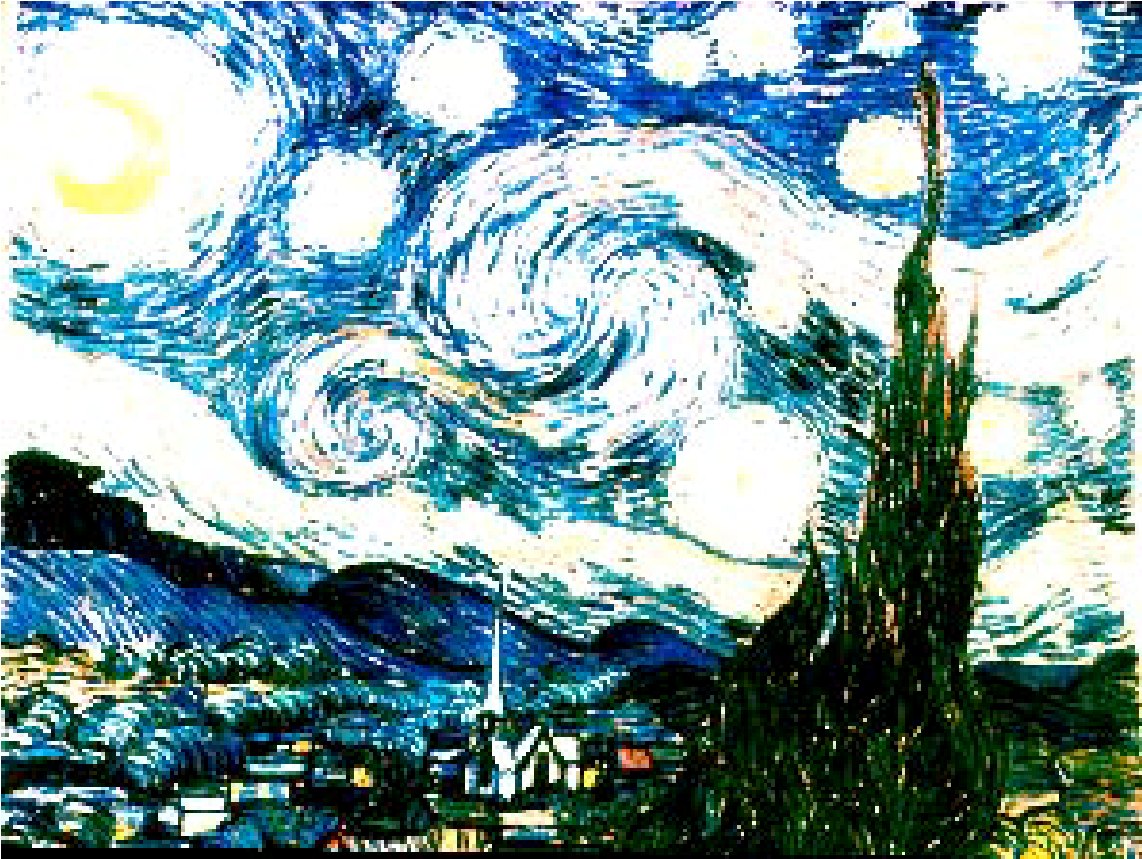
Starry Night by Van Gogh (Fig. 9-38, 1889) presaged 20th-century nonobjective styles such as the “ActionPainting.” of De Kooning and Pollock.
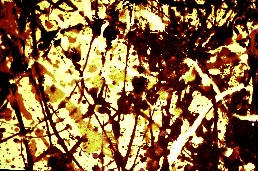
A somewhat “Baroque” sense-of-scale informs Jackson Pollock’s Autumn Rhythm (Fig. 9-39, 1950, and detail) -- a fitting apotheosis of direct technique in mid-20th century. Deprived of Van Gogh’s representational function, the skein of Pollock’s gestures fuses decorative playfulness with unvarnished subjectivity.
